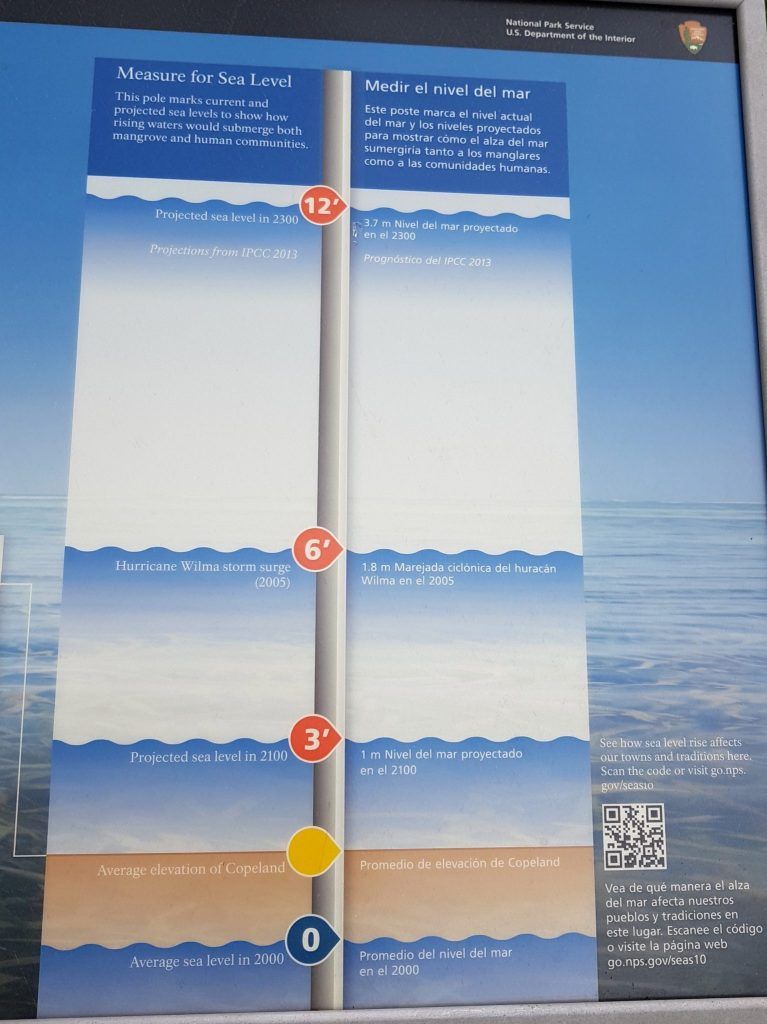A field guide to the Green New Deal
By Dan Drollette Jr | March 13, 2019
 Informational plaque on a pole outside the ranger station at the Big Cypress Swamp Welcome Center at Ochopee, Florida, showing how much the sea level will rise in the Everglades, using more conservative estimates.
Informational plaque on a pole outside the ranger station at the Big Cypress Swamp Welcome Center at Ochopee, Florida, showing how much the sea level will rise in the Everglades, using more conservative estimates.
Journalists love acronyms.
They’re a shorthand method of getting across what would otherwise be a cumbersome mouthful, and they free up valuable space in a headline. And let’s face it, it’s a lot easier to type “INF” than “Intermediate-Range Nuclear Forces Treaty,” particularly if you have an article on deadline peppered with the term.
Which is why “Frequently Asked Questions” gets abbreviated as “FAQ,” “Alexandria Ocasio-Cortez” becomes “AOC,” and “Green New Deal” gets transmogrified into “GND.”
But there’s a downside to the use of acronyms, as can be seen when a phrase such as “Answers to Frequently Asked Questions about Alexandria Ocasio-Cortez’s Green New Deal” gets turned into something like “FAQ: AOC’s GND.”
A lot of confusion can result.
Which may be one contributing factor when it comes to why there is just so much plain confusion about the contents of the Green New Deal. And why Sen. Tom Cotton (R-Arkansas) was able to get away with telling conservative radio host Hugh Hewitt that the proposal “was going to confiscate every privately owned vehicle in America within a decade and ban air travel so we could all drive or ride around on high-speed light rail, supposedly powered by unicorn tears.”
(For the record the deal does not call for any cars to be confiscated. And Sen. Cotton is the first person to bring up unicorn tears.)
And Cotton is not alone. Green New Deal opponent Sen John Barrasso (R- Wyoming) wrote in a press release that ice cream, cheeseburgers and milkshakes would be a thing of the past because under the Green New Deal, “livestock will be banned.”
(Fact check: Our ice cream, burgers, and milkshakes are safe. And the proposal doesn’t ban livestock.)
To counter such misinformation, the New York Times recently published an article by Lisa Friedman titled “What is the Green New Deal—A Climate Proposal, Explained.” It acts as a handy quick-reference guide, or FAQ (sorry!) as to exactly what is in the deal — which, to be fair to opponents of the proposed legislation, has evolved and changed rapidly in a relatively short span of time.
The article addresses the basics of the situation, often described in Journalism 101 college classes as the “Five W’s” of who, what, where, when, and why:
Who is behind the Green New Deal? The program is formally sponsored by New York state representative Alexandria Ocasio-Cortez and Massachusetts Sen. Edward Markey, with help from youth activist groups and others.
What are its goals? To wean the country from fossil fuels and curb greenhouse gas emissions.
Where? Nationwide.
When? By the year 2030.
Why? To avoid planetary destruction, and keep Miami Beach from becoming a trillion-dollar sea.
The article also goes into some of the more difficult “how’s” of the proposal, along with its likely costs and benefits.
Meanwhile, a companion New York Times article by Friedman and Trip Gabriel (“A Green New Deal Is Technologically Possible, Its Political Prospects Are Another Question”) goes into the deal’s chances on Capitol Hill.
If nothing else, the Green New Deal seems to be firmly on the political agenda for 2020 — which was certainly not the case in the last presidential election.
(To read the 14-page House Resolution proposal in full, go to this link.)
Publication Name: New York Times
To read what we're reading, click here
Together, we make the world safer.
The Bulletin elevates expert voices above the noise. But as an independent nonprofit organization, our operations depend on the support of readers like you. Help us continue to deliver quality journalism that holds leaders accountable. Your support of our work at any level is important. In return, we promise our coverage will be understandable, influential, vigilant, solution-oriented, and fair-minded. Together we can make a difference.
Keywords: Green New Deal, climate change, climate change communication
Topics: Climate Change, What We’re Reading














